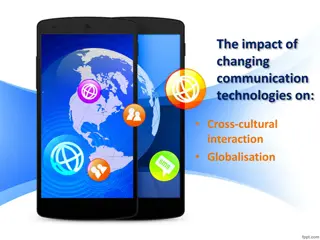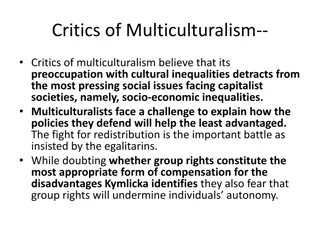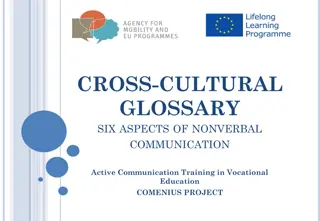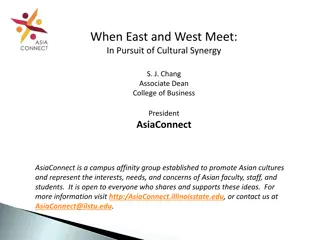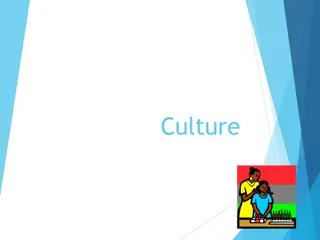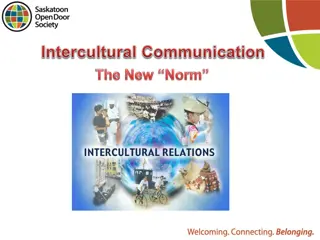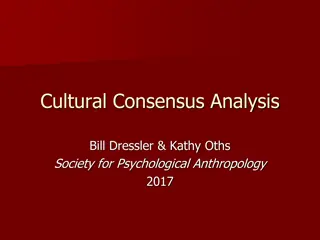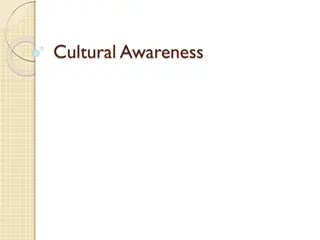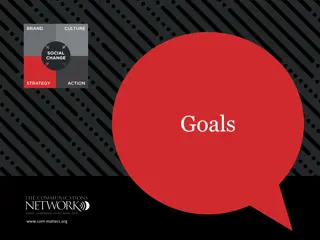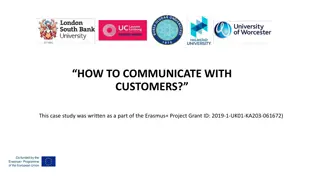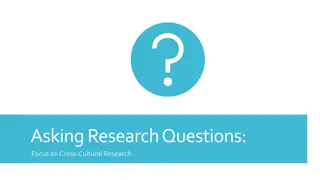Enhancing Cross-Cultural Communication: Strategies for Success
Explore the impact of cultural and linguistic differences on communication in this webinar, focusing on preparing English language learners to communicate effectively across cultures. Learn about a cross-cultural incident and discover elements of culture and communication, including nonverbal cues. Dive into types and functions of nonverbal communication and gain insights on bridging cultural gaps to foster better understanding and connection.
Uploaded on Aug 07, 2024 | 1 Views
Download Presentation

Please find below an Image/Link to download the presentation.
The content on the website is provided AS IS for your information and personal use only. It may not be sold, licensed, or shared on other websites without obtaining consent from the author.If you encounter any issues during the download, it is possible that the publisher has removed the file from their server.
You are allowed to download the files provided on this website for personal or commercial use, subject to the condition that they are used lawfully. All files are the property of their respective owners.
The content on the website is provided AS IS for your information and personal use only. It may not be sold, licensed, or shared on other websites without obtaining consent from the author.
E N D
Presentation Transcript
Webinar Goals In this webinar we will attempt to Recognize how cultural and linguistic differences affect communication Discuss the importance of preparing learners to communicate across cultures successfully Share activities that raise cultural and linguistic awareness among English Language Learners
Cross-Cultural Incident Clara is an American attending a university in Norway. She has made a few friends. One morning, on her way to class, she sees her friend Johann walking ahead of her. She shouts and runs to catch up with Johann. Clara smiles and attempts to make conversation, but Johann doesn t smile or say much except that he must get to class. Clara says good-bye feeling confused and hurt. She thought they were friends and wonders if she did something to upset Johann.
Bridging Cultures: Elements of Culture and Communication Nonverbal communication Verbal communication Identity Values Social norms
Culture and Nonverbal Communication Nonverbal communication differs among cultures The way that we understand nonverbal codes differs among cultures
Types of Nonverbal Communication Gestures Body Movement Eye Movement
Types of NonVerbal Communication Clothing and Dress Um Vocalics Time
Types of Nonverbal Communication Space Touch
Functions of Nonverbal Communication
Cross-Cultural Incident Clara is an American attending a university in Norway. She has made a few friends. One morning, on her way to class, she sees her friend Johann walking ahead of her. She shouts and runs to catch up with Johann. Clara smiles and attempts to make conversation, but Johann doesn t smile or say much except that he must get to class. Clara says good-bye feeling confused and hurt. She thought they were friends and wonders if she did something to upset Johann.
Teaching Nonverbal Communication Testing gestures Space exercise Vocalics of English and first language
Sharing Gestures Goal: To highlight the differences in some simple nonverbal codes * Students stand in a circle * Teacher calls out a word/phrase * Students must perform the associated movement or gesture
Using Space and Touch Goal: To recognize that people use and value space differently * Send half of the students out of the room * The remaining students are told this: * You will have a conversation with a student when they return * As you talk you will move closer and closer to your partner * Observe your partner s reaction and your own * Bring the other students back to find a partner
Vocalics as Communication Goal: To identify some of the nonverbal sounds used in English to communicate meaning The teacher will make sounds in English that relate to particular phrases/words Example: uh-huh, hmmm (with rising intonation) Students must try to identify what these sounds mean
Verbal Communication Theory of Linguistic Relativism or Sapir-Whorf Hypothesis Language shapes and influences how we view the world We can learn to use and understand new languages and cultures Think about this: The way we think is filtered through our own language, so what relationship is there between culture and language?
Culture and Verbal Communication Written Oral Language Rules (Sounds, Grammar, Meaning)
Cross-Cultural Incident Clara is an American attending a university in Norway. She has made a few friends. One morning, on her way to class, she sees her friend Johann walking ahead of her. She shouts and runs to catch up with Johann. Clara smiles and attempts to make conversation, but Johann doesn t smile or say much except that he must get to class. Clara says good-bye feeling confused and hurt. She thought they were friends and wonders if she did something to upset Johann.
Teaching Verbal Communication Language of relationships Making requests Writing appropriate emails Extension: Prepare an email request and a spoken request; ask students to identify differences
Language of Relationships Goal: To practice the language of relationships and show how language might create different beliefs about relationships across cultures * Ask students to generate family vocabulary Mother Father Aunt Uncle * Work as a large group to determine how the word in English differs from the word in the L1 * Give students time to do a few in small groups or pairs * Ask students why these differences might exist
Making Requests Goal: To recognize the appropriate way to make a request in English * Working in groups have students arrange the cards so that the person, request, and phrase work together to be pragmatically appropriate * Then students must complete the request
Writing Emails Goal: To practice writing polite emails in English
Culture and Identity Personal identity within each of us is formed by different aspects joining together. These can include: Personalities, goals, and interests Religious beliefs Social class and status (income, education, family) Language Gender Social roles Ethnicity
Cross-Cultural Incident Clara is an American attending a university in Norway. She has made a few friends. One morning, on her way to class, she sees her friend Johann walking ahead of her. She shouts and runs to catch up with Johann. Clara smiles and attempts to make conversation, but Johann doesn t smile or say much except that he must get to class. Clara says good-bye feeling confused and hurt. She thought they were friends and wonders if she did something to upset Johann.
Teaching Culture and Identity Who am I? How are we different? (Peace Corps Lesson) Girls and boys (Gender Identity) Clothing and impressions
Who Am I? Goal: To support self-discovery through brainstorming and self-reflection through writing and discussion * Ask students to list or think of ten words in English about themselves * Pair or group students and have them share there lists * Once they ve shared, put them to work writing the information into a paragraph to share * When they ve finished they can return to their groups to share their description.
How are we different? Goal: To extend the conversation on identity and generate empathy as students recognize differences in others * This activity comes from U.S. Peace Corps website: http://www.peacecorps.gov/wws/lesson-plans/everyone-has-culture-everyone-different/
Clothing and Impressions * Goal: To recognize and develop knowledge about how we use clothing to give people details about ourselves * Have students look around the room * What can they tell about each other based on what they are wearing/carrying? * Give students a list of people. Have them work in groups to generate the clothing each person might wear to show who they are * When finished, bring students back together and ask them to reflect on what their own style says about themselves. What do they want to say about themselves through appearance?
Culture and Values Not Doing Harm Fairness Authority Purity Community/Group Loyalty Me You Identity shapes values; both influence behavior An older friend, Sam, meets you for coffee dressed in an outfit that you think is too informal. In fact, your friend is wearing a swimsuit. How do you respond?
Culture and Cultural Norms Cultural norms = Behavior and rules They are learned early and reinforced often These rules make us very ethnocentric (our rules are the only rules) and are the cause of many cultural miscommunications Learning that other cultural norms exist can help us be more accepting and reduce instances of cultural miscommunication
Cross-Cultural Incident Clara is an American attending a university in Norway. She has made a few friends. One morning, on her way to class, she sees her friend Johann walking ahead of her. She shouts and runs to catch up with Johann. Clara smiles and attempts to make conversation, but Johann doesn t smile or say much except that he must get to class. Clara says good-bye feeling confused and hurt. She thought they were friends and wonders if she did something to upset Johann.
Teaching Values & Cultural Norms Greetings across cultures Spot the difference Cross-cultural incidents
Spot the Difference Goal: To recognize that everyday activities, living arrangements, and habits vary around the world and generate discussion on how to handle those differences * Show drawings or pictures of everyday activities taking place in the U.S. * How are these different from their own daily activities? * What would they do if they were in the U.S. and were asked to act in a different way?
Cross-Cultural Incidents Goal: To use a cross-cultural incident as a way to prompt discussion about communicating across cultures * Readily available on the Internet * Provide students with a case study as a way to work through cross-cultural communication and generate possible solutions
Final Thoughts Teach students to Ask questions Observe Make mistakes Teach people about new ways and cultures www.americanenglish.state.gov American English for Educators Facebook Page
Thank You References NorQuest College (2007). Critical incidents for intercultural communication: An interactive tool for developing awareness, knowledge, and skills. https:// www.norquest.ca/NorquestCollege/media/pdf/centres/intercultural/ CriticalIncidentsBooklet.pdf Pinker, S. (2008, January 13). The moral instinct. The New York Times Magazine. http://www.nytimes.com/2008/01/13/magazine/13Psychology-t.html Robson, D. (2013, January 14). There really are 50 Eskimo words for snow . The Washington Post Retrieved from https://www.washingtonpost.com/ national/health-science/there-really-are-50-eskimo-words-for-snow/ 2013/01/14/e0e3f4e0-59a0-11e2-beee-6e38f5215402_story.html Samovar, L. A., Porter, R. E., McDaniel, E. R., & Roy, C. S. (2013). Communication between cultures (8th ed.). Boston: Wadsworth/Cengage Learning. Schaeffer, K. M. (2014). Verbal Communication [PowerPoint Slides]. Salt Lake City, UT. Wintergerst, A. C., & McVeigh, J. (2011). Tips for teaching culture: Practical approaches to intercultural communication. White Plains, NY: Pearson Longman.




